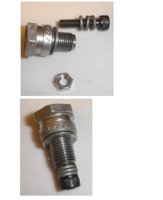smg65
XS650 Addict
This question is related to a thread I previously started regarding locating TDC on a PMA equipped bike. I finally had a chance to play around with it this weekend, and I found that my old Yamaha dial indicator that I was going to use is behaving in a "sticky"manner. Perhaps it's because I don't have a wheel on the tip to ease the movement. I've been reading about all the different methods, and I thought I would try the piston stop method. And although it appears that a degree wheel is not necessary for simply finding TDC, I thought it would be a nice tool to have and I could also use it in conjunction with the piston stop.
I know... this is probably a stupid question! But not owning a degree wheel and wanting to use one, I found that the printable ones seem like they would be too large to be conveniently and efficiently used for this purpose. Backing up... I want to use one with just the inspection cover off... nothing else disassembled or removed. I've searched this question, and I haven't found it answered. Perhaps the answer is just too simple and obvious for me!
But not owning a degree wheel and wanting to use one, I found that the printable ones seem like they would be too large to be conveniently and efficiently used for this purpose. Backing up... I want to use one with just the inspection cover off... nothing else disassembled or removed. I've searched this question, and I haven't found it answered. Perhaps the answer is just too simple and obvious for me! 
I printed one out, and it was huge. The gear shift would need to be removed (not a problem at all... but why??). I know I can easily resize the degree wheel image. But... before I waste a bunch of paper... what diameter degree wheel would you guys find most convenient to use for this purpose? Also... any tips on a pointer? Or... quite possibly... am I totally off base with these questions??
Thanks!! And thanks for putting up with my questions!
My original thread regarding tools for determining TDC: http://www.xs650.com/forum/showthread.php?t=36321
I know... this is probably a stupid question!
 But not owning a degree wheel and wanting to use one, I found that the printable ones seem like they would be too large to be conveniently and efficiently used for this purpose. Backing up... I want to use one with just the inspection cover off... nothing else disassembled or removed. I've searched this question, and I haven't found it answered. Perhaps the answer is just too simple and obvious for me!
But not owning a degree wheel and wanting to use one, I found that the printable ones seem like they would be too large to be conveniently and efficiently used for this purpose. Backing up... I want to use one with just the inspection cover off... nothing else disassembled or removed. I've searched this question, and I haven't found it answered. Perhaps the answer is just too simple and obvious for me! 
I printed one out, and it was huge. The gear shift would need to be removed (not a problem at all... but why??). I know I can easily resize the degree wheel image. But... before I waste a bunch of paper... what diameter degree wheel would you guys find most convenient to use for this purpose? Also... any tips on a pointer? Or... quite possibly... am I totally off base with these questions??
Thanks!! And thanks for putting up with my questions!
My original thread regarding tools for determining TDC: http://www.xs650.com/forum/showthread.php?t=36321




 I left the rod in place to keep things centered, being careful not to weld the rod to the nuts. After letting it set overnight, I installed the washer and 3rd nut (these to provide a "lockdown"), and Locktited the acorn nut to give me something better to grip. The whole affair seems very solid.
I left the rod in place to keep things centered, being careful not to weld the rod to the nuts. After letting it set overnight, I installed the washer and 3rd nut (these to provide a "lockdown"), and Locktited the acorn nut to give me something better to grip. The whole affair seems very solid. 